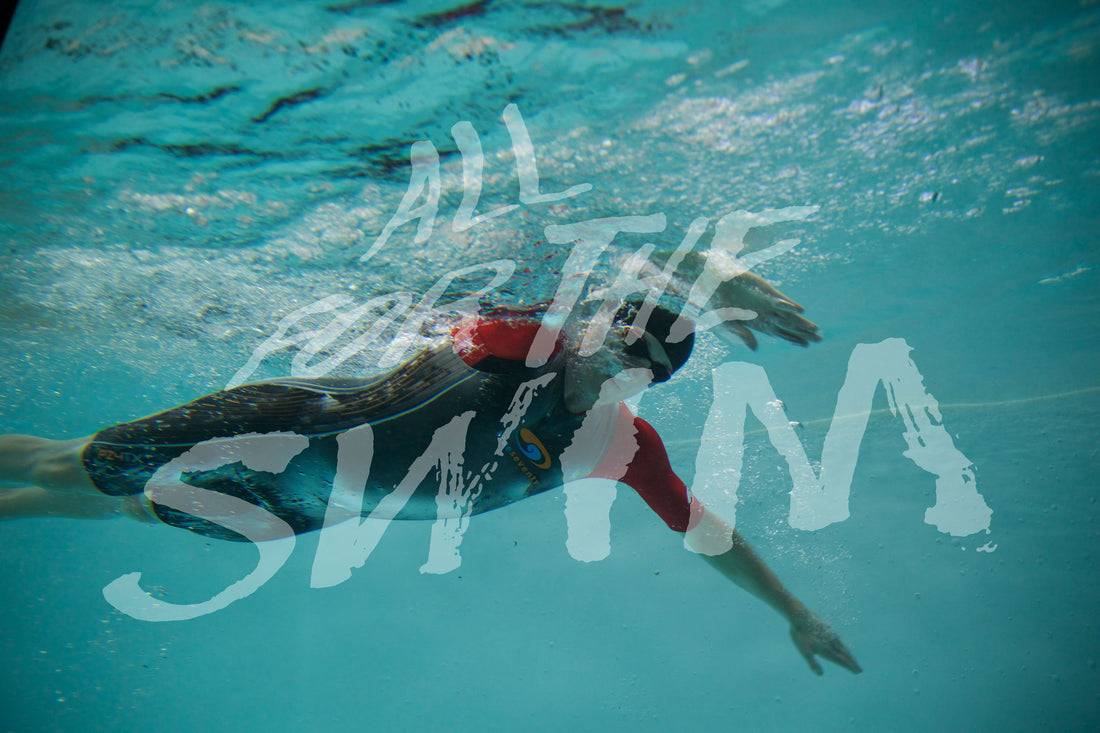Why wear a swim wetsuit…not just so you look like a stealth mammal, but to keep warm, glide effortlessly through the water and take the free speed from the additional buoyancy. With 25 years of innovation, blueseventy has all the insider information on what makes and great suit and what to look for (and they are not all the same).
Why wear a swim wetsuit

Swim wetsuits are made for the express purpose of surface swimming. Originally introduced to maintain warmth when swimming in cold open water and to provide additional buoyancy for safety purposes, their benefits are significant including reducing drag, speed enhancement through additional buoyancy (and better body position) and protection from the elements (keeping the sun off and protection against the odd jellyfish etc.)
This has resulted in swim wetsuits becoming a highly technical, performance component of both open water swimming and triathlon. (blueseventy was one of the first to innovate in this area – we’ve been in this game for over 25 years!)
If you don’t normally wear a wetsuit when ocean swimming head down and see the blueseventy team at an event near you or one of our great retail partners. Try on one of our wetsuits and see for yourself the change it makes to your swimming!
How do they work?
Swim wetsuits provide greatly enhanced buoyancy for the swimmer bringing the body higher out the water providing better water displacement, lower surface friction resulting in a swim skin that cuts through the water. Different designs and materials provide varying levels of performance enhancement to consider.
- Surface friction: All blueseventy wetsuits are manufactured with a hydrophobic outer skin. This rubber has a silicon type surface treatment, which has much the same effect as Teflon in a pan. This slippery surface improves the glide benefit of the wetsuit by reducing surface resistance.
- Design: In addition to limiting water entry, fit can make for a comfortable, or chaffing swim so is vitally important. (So it needs to fit snugly) (See below) Additionally male and female general anatomy mean that a good design will fit your body type in the right places.
- Flexibility: Flexibility, freedom of movement, and stroke rotation are crucial factors.
- Breathing: Sustained performance will be compromised if the wetsuit is too restrictive around the torso (chest) or throat. Any reduction in lung capacity reduces the level of O2 in the bloodstream with a resulting loss of power in the muscles. Look for a flexible non-restrictive suit for greater performance enhancements. Always go for a firm but comfortable fit.
HOW DOES A BLUESEVENTY WETSUIT MAKE ME FASTER?
The primary function of a swim wetsuit is the provision of additional buoyancy. This additional buoyancy results in less drag as the body is positioned higher out of the water. The result is a maximised performance potential.
All wetsuits are made of "neoprene rubber". Neoprene is naturally buoyant albeit different types of neoprene have different rates of buoyancy. For swim wetsuits, the neoprene that is used has maximum number of air cells - like a honey comb effect of microscopic air bubbles. This means that it is lighter, more flexible and more buoyant.
In the case of normal surfing and diving type wetsuits, neoprene is laminated on each side with nylon fabric. This helps to protect the rubber against abrasion. Swim wetsuits, have one side (being the external surface) left as raw rubber, coated with a special low friction coating called "super composite skin". This special coating has a very low rate of friction and it therefore glides more easily through the water.
In theory, the most buoyant (and therefore fastest) wetsuit would be one made of the thickest possible material. However, swimming in such a wetsuit would require far greater muscular force to rotate the arms and freely move the body. Consequently, swim wetsuits are made with a variety of rubber thicknesses. Typically, 5mm rubber is used in the main front body area to maximize buoyancy. 3mm is used across the back to aid freedom of movement, and 2mm rubber is used in the sleeves and allowing total freedom for the swimming stroke.
At blueseventy, we are always looking for the right blend of buoyancy, flexibility and cutting-edge materials to make sure that our suits are the fastest they can possibly be.
(Note: The maximum neoprene thickness allowable under International Triathlon Union regulations is 5mm).
Getting the right fit is important
Naturally it is important that your wetsuit does not balloon with water as this will greatly reduce buoyancy and increase drag. However, what many do not realise that the opposite of this (i.e. having a suit too tight) can have an equal, if not greater, negative impact on your performance. A suit that is too tight will greatly impede flexibility, increase muscle fatigue, and reduce the breathing capacity of your lungs combining to significantly compromise your swim.
One school of thought has developed within the triathlon/open water swim community is that the best wetsuit is one that is virtually water tight, prompting some to buy a wetsuit that is one size too small. Don’t – it’s not true!
To test the theory of how tight is right, we conducted a time test exercise within a controlled environment (pool). Results consistently showed that those wearing suits carrying a small amount of water inside were averaging 2 to 4 seconds of speed advantage per 100m over those wearing a size too small. It was also evident in the too tight-fit group that a greater amount of metabolic exertion (energy) had been required to undertake the same swim distances. (So they got more tired)
So just how much water is acceptable? If any water layer or pocket is ballooning the suit more than a 5mm off the body then your wetsuit may be too big. The right size suit may carry a very small layer of internal water in some areas. Water entry is normal in a wetsuit, but too much water will add to the weight of your suit and reduce your buoyancy and speed.
If you feel some water movement around the inside of your suit then don’t worry, it is probably an ideal fit as the lack of restriction or constriction means your performance is not limited.
So choose your suit wisely – and use our 25 years plus of experience to choose the correct size click here. (And yes, there is a different between girls and guys fit)
So all in all – a wetsuit will help you enjoy your swim and enhance your base performance.

